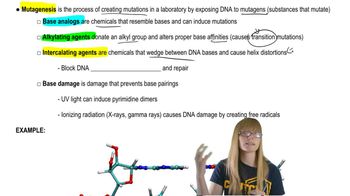Table of contents
- 1. Introduction to Genetics51m
- 2. Mendel's Laws of Inheritance3h 37m
- 3. Extensions to Mendelian Inheritance2h 41m
- 4. Genetic Mapping and Linkage2h 28m
- 5. Genetics of Bacteria and Viruses1h 21m
- 6. Chromosomal Variation1h 48m
- 7. DNA and Chromosome Structure56m
- 8. DNA Replication1h 10m
- 9. Mitosis and Meiosis1h 34m
- 10. Transcription1h 0m
- 11. Translation58m
- 12. Gene Regulation in Prokaryotes1h 19m
- 13. Gene Regulation in Eukaryotes44m
- 14. Genetic Control of Development44m
- 15. Genomes and Genomics1h 50m
- 16. Transposable Elements47m
- 17. Mutation, Repair, and Recombination1h 6m
- 18. Molecular Genetic Tools19m
- 19. Cancer Genetics29m
- 20. Quantitative Genetics1h 26m
- 21. Population Genetics50m
- 22. Evolutionary Genetics29m
17. Mutation, Repair, and Recombination
Types of Mutations
Problem 33a
Textbook Question
Textbook QuestionIn an experiment employing the methods of the Ames test, two strains of Salmonella are used. Strain A contains a base-substitution mutation, and Strain B contains a frameshift mutation. Four plates are prepared to test the mutagenicity of the compound ethyl methanesulfonate (EMS). Plate 1 is a control plate with Strain A and S9 extract but no EMS. Plate 2 is also a control plate and contains Strain B and S9 extract but no EMS. Plate 3 contains Strain A along with S9 extract and EMS, and Plate 4 contains Strain B, S9 extract, and EMS. Characterize the expected distribution of colony growth on the four plates. Defend your growth prediction for each plate.
 Verified Solution
Verified SolutionThis video solution was recommended by our tutors as helpful for the problem above
Video duration:
4mPlay a video:
Was this helpful?
Key Concepts
Here are the essential concepts you must grasp in order to answer the question correctly.
Ames Test
The Ames test is a widely used method for assessing the mutagenic potential of chemical compounds. It employs specific strains of bacteria, typically Salmonella, that are sensitive to mutations. By observing the growth of these bacteria in the presence of a potential mutagen, researchers can infer whether the compound causes genetic changes that lead to increased colony formation.
Recommended video:
Guided course

Induced Mutations
Types of Mutations
Mutations can be classified into various types, with base-substitution and frameshift mutations being two primary categories. A base-substitution mutation involves the replacement of one nucleotide with another, potentially altering a single amino acid in a protein. In contrast, a frameshift mutation results from the insertion or deletion of nucleotides, shifting the reading frame and often leading to a completely different and nonfunctional protein.
Recommended video:
Guided course

Mutations and Phenotypes
S9 Extract
S9 extract is a metabolic activation system derived from the liver of rodents, used in mutagenicity testing to simulate the metabolic processes that occur in living organisms. It contains enzymes that can convert pro-mutagens into their active forms, allowing researchers to assess the mutagenic effects of compounds like ethyl methanesulfonate (EMS) under conditions that mimic biological metabolism.
Recommended video:
Guided course

Traditional vs. Next-Gen

 9:49m
9:49mWatch next
Master Point Mutations with a bite sized video explanation from Kylia Goodner
Start learning


